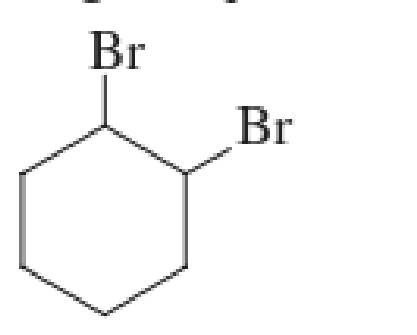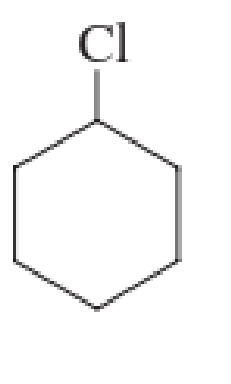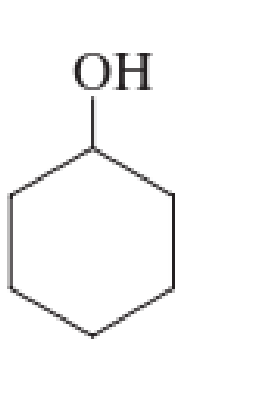
General, Organic, and Biological Chemistry
7th Edition
ISBN: 9781285853918
Author: H. Stephen Stoker
Publisher: Cengage Learning
expand_more
expand_more
format_list_bulleted
Concept explainers
Textbook Question
Chapter 13, Problem 13.79EP
What reactant would you use to prepare each of the following compounds from cyclohexene?




Expert Solution & Answer
Trending nowThis is a popular solution!

Students have asked these similar questions
A certain half-reaction has a standard reduction potential Ered +1.26 V. An engineer proposes using this half-reaction at the anode of a galvanic cell that
must provide at least 1.10 V of electrical power. The cell will operate under standard conditions.
Note for advanced students: assume the engineer requires this half-reaction to happen at the anode of the cell.
Is there a minimum standard reduction
potential that the half-reaction used at
the cathode of this cell can have?
If so, check the "yes" box and calculate
the minimum. Round your answer to 2
decimal places. If there is no lower
limit, check the "no" box..
Is there a maximum standard reduction
potential that the half-reaction used at
the cathode of this cell can have?
If so, check the "yes" box and calculate
the maximum. Round your answer to 2
decimal places. If there is no upper
limit, check the "no" box.
yes, there is a minimum.
1
red
Πν
no minimum
Oyes, there is a maximum.
0
E
red
Dv
By using the information in the ALEKS…
In statistical thermodynamics, check the
hcv
following equality: ß Aɛ =
KT
Please correct answer and don't used hand raiting
Chapter 13 Solutions
General, Organic, and Biological Chemistry
Ch. 13.1 - Prob. 1QQCh. 13.1 - Prob. 2QQCh. 13.1 - Prob. 3QQCh. 13.2 - Prob. 1QQCh. 13.2 - Prob. 2QQCh. 13.2 - Prob. 3QQCh. 13.2 - Prob. 4QQCh. 13.3 - Prob. 1QQCh. 13.3 - Prob. 2QQCh. 13.3 - Prob. 3QQ
Ch. 13.3 - Prob. 4QQCh. 13.4 - Prob. 1QQCh. 13.4 - Prob. 2QQCh. 13.5 - Prob. 1QQCh. 13.5 - Prob. 2QQCh. 13.5 - Prob. 3QQCh. 13.6 - Prob. 1QQCh. 13.6 - Prob. 2QQCh. 13.6 - Prob. 3QQCh. 13.7 - Prob. 1QQCh. 13.7 - Prob. 2QQCh. 13.7 - Prob. 3QQCh. 13.8 - Prob. 1QQCh. 13.8 - Prob. 2QQCh. 13.9 - Prob. 1QQCh. 13.9 - Prob. 2QQCh. 13.10 - Prob. 1QQCh. 13.10 - Prob. 2QQCh. 13.10 - Prob. 3QQCh. 13.10 - Prob. 4QQCh. 13.10 - Prob. 5QQCh. 13.11 - Prob. 1QQCh. 13.11 - Prob. 2QQCh. 13.11 - Prob. 3QQCh. 13.11 - Prob. 4QQCh. 13.11 - Prob. 5QQCh. 13.12 - Prob. 1QQCh. 13.12 - Prob. 2QQCh. 13.12 - Prob. 3QQCh. 13.12 - Prob. 4QQCh. 13.12 - Prob. 5QQCh. 13.13 - Prob. 1QQCh. 13.13 - Prob. 2QQCh. 13.13 - Prob. 3QQCh. 13.14 - Prob. 1QQCh. 13.14 - Prob. 2QQCh. 13.14 - Prob. 3QQCh. 13.14 - Prob. 4QQCh. 13.15 - Prob. 1QQCh. 13.15 - Prob. 2QQCh. 13.15 - Prob. 3QQCh. 13.15 - Prob. 4QQCh. 13.16 - Prob. 1QQCh. 13.16 - Prob. 2QQCh. 13 - Classify each of the following hydrocarbons as...Ch. 13 - Classify each of the following hydrocarbons as...Ch. 13 - Prob. 13.3EPCh. 13 - Prob. 13.4EPCh. 13 - Prob. 13.5EPCh. 13 - Prob. 13.6EPCh. 13 - Prob. 13.7EPCh. 13 - Prob. 13.8EPCh. 13 - Prob. 13.9EPCh. 13 - What is the molecular formula for each of the...Ch. 13 - Prob. 13.11EPCh. 13 - Prob. 13.12EPCh. 13 - What is wrong, if anything, with the following...Ch. 13 - Prob. 13.14EPCh. 13 - Prob. 13.15EPCh. 13 - Prob. 13.16EPCh. 13 - Prob. 13.17EPCh. 13 - Prob. 13.18EPCh. 13 - Draw a condensed structural formula for each of...Ch. 13 - Draw a condensed structural formula for each of...Ch. 13 - The following names are incorrect by IUPAC rules....Ch. 13 - The following names are incorrect by IUPAC rules....Ch. 13 - Prob. 13.23EPCh. 13 - Prob. 13.24EPCh. 13 - Prob. 13.25EPCh. 13 - Classify each of the following compounds as...Ch. 13 - Prob. 13.27EPCh. 13 - How many hydrogen atoms are present in a molecule...Ch. 13 - Prob. 13.29EPCh. 13 - Draw a line-angle structural formula for each of...Ch. 13 - Prob. 13.31EPCh. 13 - Prob. 13.32EPCh. 13 - Prob. 13.33EPCh. 13 - Prob. 13.34EPCh. 13 - Prob. 13.35EPCh. 13 - Prob. 13.36EPCh. 13 - Prob. 13.37EPCh. 13 - Prob. 13.38EPCh. 13 - For each of the following pairs of alkenes,...Ch. 13 - Prob. 13.40EPCh. 13 - Prob. 13.41EPCh. 13 - Prob. 13.42EPCh. 13 - Prob. 13.43EPCh. 13 - Prob. 13.44EPCh. 13 - Prob. 13.45EPCh. 13 - Prob. 13.46EPCh. 13 - For each molecule, indicate whether cistrans...Ch. 13 - For each molecule, indicate whether cistrans...Ch. 13 - Prob. 13.49EPCh. 13 - Prob. 13.50EPCh. 13 - Prob. 13.51EPCh. 13 - Draw a structural formula for each of the...Ch. 13 - Prob. 13.53EPCh. 13 - Prob. 13.54EPCh. 13 - Prob. 13.55EPCh. 13 - Prob. 13.56EPCh. 13 - Prob. 13.57EPCh. 13 - Prob. 13.58EPCh. 13 - Why is the number of carbon atoms in a terpene...Ch. 13 - How many isoprene units are present in a....Ch. 13 - Prob. 13.61EPCh. 13 - Indicate whether each of the following statements...Ch. 13 - Prob. 13.63EPCh. 13 - With the help of Figure 13-7, indicate whether...Ch. 13 - Prob. 13.65EPCh. 13 - Prob. 13.66EPCh. 13 - Prob. 13.67EPCh. 13 - Prob. 13.68EPCh. 13 - Prob. 13.69EPCh. 13 - Prob. 13.70EPCh. 13 - Prob. 13.71EPCh. 13 - Prob. 13.72EPCh. 13 - Prob. 13.73EPCh. 13 - Prob. 13.74EPCh. 13 - Prob. 13.75EPCh. 13 - Write a chemical equation showing reactants,...Ch. 13 - Supply the structural formula of the product in...Ch. 13 - Prob. 13.78EPCh. 13 - What reactant would you use to prepare each of the...Ch. 13 - Prob. 13.80EPCh. 13 - Prob. 13.81EPCh. 13 - Prob. 13.82EPCh. 13 - Prob. 13.83EPCh. 13 - Prob. 13.84EPCh. 13 - Prob. 13.85EPCh. 13 - Prob. 13.86EPCh. 13 - Prob. 13.87EPCh. 13 - Prob. 13.88EPCh. 13 - Prob. 13.89EPCh. 13 - Prob. 13.90EPCh. 13 - Prob. 13.91EPCh. 13 - Prob. 13.92EPCh. 13 - Prob. 13.93EPCh. 13 - What are the bond angles about the triple bond in...Ch. 13 - Prob. 13.95EPCh. 13 - Prob. 13.96EPCh. 13 - Prob. 13.97EPCh. 13 - Prob. 13.98EPCh. 13 - Prob. 13.99EPCh. 13 - Prob. 13.100EPCh. 13 - Prob. 13.101EPCh. 13 - Prob. 13.102EPCh. 13 - Prob. 13.103EPCh. 13 - Prob. 13.104EPCh. 13 - Prob. 13.105EPCh. 13 - Prob. 13.106EPCh. 13 - Prob. 13.107EPCh. 13 - Prob. 13.108EPCh. 13 - Assign each of the compounds in Problem 13-107 an...Ch. 13 - Assign each of the compounds in Problem 13-108 an...Ch. 13 - Prob. 13.111EPCh. 13 - Prob. 13.112EPCh. 13 - Prob. 13.113EPCh. 13 - Prob. 13.114EPCh. 13 - Prob. 13.115EPCh. 13 - Write a structural formula for each of the...Ch. 13 - Eight isomeric substituted benzenes have the...Ch. 13 - Prob. 13.118EPCh. 13 - Prob. 13.119EPCh. 13 - Prob. 13.120EPCh. 13 - Prob. 13.121EPCh. 13 - Prob. 13.122EPCh. 13 - Prob. 13.123EPCh. 13 - Prob. 13.124EPCh. 13 - Prob. 13.125EPCh. 13 - For each of the following classes of compounds,...Ch. 13 - Prob. 13.127EPCh. 13 - Prob. 13.128EPCh. 13 - Prob. 13.129EPCh. 13 - Prob. 13.130EP
Knowledge Booster
Learn more about
Need a deep-dive on the concept behind this application? Look no further. Learn more about this topic, chemistry and related others by exploring similar questions and additional content below.Similar questions
- Please correct answer and don't used hand raitingarrow_forward(11pts total) Consider the arrows pointing at three different carbon-carbon bonds in the molecule depicted below. Bond B Bond A Bond C a. (2pts) Which bond between A-C is weakest? Which is strongest? Place answers in appropriate boxes. Weakest Bond Strongest Bond b. (4pts) Consider the relative stability of all cleavage products that form when bonds A, B, AND C are homolytically cleaved/broken. Hint: cleavage products of bonds A, B, and C are all carbon radicals. i. Which ONE cleavage product is the most stable? A condensed or bond line representation is fine. ii. Which ONE cleavage product is the least stable? A condensed or bond line representation is fine. c. (5pts) Use principles discussed in lecture, supported by relevant structures, to succinctly explain the why your part b (i) radical is more stable than your part b(ii) radical. Written explanation can be no more than one-two succinct sentence(s)!arrow_forward. 3°C with TH 12. (10pts total) Provide the major product for each reaction depicted below. If no reaction occurs write NR. Assume heat dissipation is carefully controlled in the fluorine reaction. 3H 24 total (30) 24 21 2h • 6H total ● 8H total 34 래 Br2 hv major product will be most Substituted 12 hv Br NR I too weak of a participate in P-1 F₂ hv Statistically most favored product will be major = most subst = thermo favored hydrogen atom abstractor to LL Farrow_forward
- Five chemistry project topic that does not involve practicalarrow_forwardPlease correct answer and don't used hand raitingarrow_forwardQ2. Consider the hydrogenation of ethylene C2H4 + H2 = C2H6 The heats of combustion and molar entropies for the three gases at 298 K are given by: C2H4 C2H6 H2 AH comb/kJ mol¹ -1395 -1550 -243 Sº / J K¹ mol-1 220.7 230.4 131.1 The average heat capacity change, ACP, for the reaction over the temperature range 298-1000 K is 10.9 J K¹ mol¹. Using these data, determine: (a) the standard enthalpy change at 800 K (b) the standard entropy change at 800 K (c) the equilibrium constant at 800 K.arrow_forward
- 13. (11pts total) Consider the arrows pointing at three different carbon-carbon bonds in the molecule depicted below. Bond B Bond A Bond C a. (2pts) Which bond between A-C is weakest? Which is strongest? Place answers in appropriate boxes. Weakest Bond Strongest Bond b. (4pts) Consider the relative stability of all cleavage products that form when bonds A, B, AND C are homolytically cleaved/broken. Hint: cleavage products of bonds A, B, and C are all carbon radicals. i. Which ONE cleavage product is the most stable? A condensed or bond line representation is fine. ii. Which ONE cleavage product is the least stable? A condensed or bond line representation is fine. c. (5pts) Use principles discussed in lecture, supported by relevant structures, to succinctly explain the why your part b (i) radical is more stable than your part b(ii) radical. Written explanation can be no more than one-two succinct sentence(s)! Googlearrow_forwardPrint Last Name, First Name Initial Statifically more chances to abstract one of these 6H 11. (10pts total) Consider the radical chlorination of 1,3-diethylcyclohexane depicted below. 4 4th total • 6H total 래 • 4H total 21 total ZH 2H Statistical H < 3° C-H weakest - product abstraction here bund leads to thermo favored a) (6pts) How many unique mono-chlorinated products can be formed and what are the structures for the thermodynamically and statistically favored products? Product 6 Number of Unique Mono-Chlorinated Products Thermodynamically Favored Product Statistically Favored Product b) (4pts) Draw the arrow pushing mechanism for the FIRST propagation step (p-1) for the formation of the thermodynamically favored product. Only draw the p-1 step. You do not need to include lone pairs of electrons. No enthalpy calculation necessary H H-Cl Waterfoxarrow_forward10. (5pts) Provide the complete arrow pushing mechanism for the chemical transformation → depicted below Use proper curved arrow notation that explicitly illustrates all bonds being broken, and all bonds formed in the transformation. Also, be sure to include all lone pairs and formal charges on all atoms involved in the flow of electrons. CH3O II HA H CH3O-H H ①arrow_forward
- Do the Lone Pairs get added bc its valence e's are a total of 6 for oxygen and that completes it or due to other reasons. How do we know the particular indication of such.arrow_forwardNGLISH b) Identify the bonds present in the molecule drawn (s) above. (break) State the function of the following equipments found in laboratory. Omka) a) Gas mask b) Fire extinguisher c) Safety glasses 4. 60cm³ of oxygen gas diffused through a porous hole in 50 seconds. How long w 80cm³ of sulphur(IV) oxide to diffuse through the same hole under the same conditions (S-32.0.0-16.0) (3 m 5. In an experiment, a piece of magnesium ribbon was cleaned with steel w clean magnesium ribbon was placed in a crucible and completely burnt in oxy cooling the product weighed 4.0g a) Explain why it is necessary to clean magnesium ribbon. Masterclass Holiday assignmen PB 2arrow_forwardHi!! Please provide a solution that is handwritten. Ensure all figures, reaction mechanisms (with arrows and lone pairs please!!), and structures are clearly drawn to illustrate the synthesis of the product as per the standards of a third year organic chemistry course. ****the solution must include all steps, mechanisms, and intermediate structures as required. Please hand-draw the mechanisms and structures to support your explanation. Don’t give me AI-generated diagrams or text-based explanations, no wordy explanations on how to draw the structures I need help with the exact mechanism hand drawn by you!!! I am reposting this—ensure all parts of the question are straightforward and clear or please let another expert handle it thanks!!arrow_forward
arrow_back_ios
SEE MORE QUESTIONS
arrow_forward_ios
Recommended textbooks for you
 Organic And Biological ChemistryChemistryISBN:9781305081079Author:STOKER, H. Stephen (howard Stephen)Publisher:Cengage Learning,
Organic And Biological ChemistryChemistryISBN:9781305081079Author:STOKER, H. Stephen (howard Stephen)Publisher:Cengage Learning, General, Organic, and Biological ChemistryChemistryISBN:9781285853918Author:H. Stephen StokerPublisher:Cengage Learning
General, Organic, and Biological ChemistryChemistryISBN:9781285853918Author:H. Stephen StokerPublisher:Cengage Learning Chemistry: Principles and PracticeChemistryISBN:9780534420123Author:Daniel L. Reger, Scott R. Goode, David W. Ball, Edward MercerPublisher:Cengage Learning
Chemistry: Principles and PracticeChemistryISBN:9780534420123Author:Daniel L. Reger, Scott R. Goode, David W. Ball, Edward MercerPublisher:Cengage Learning Chemistry: Principles and ReactionsChemistryISBN:9781305079373Author:William L. Masterton, Cecile N. HurleyPublisher:Cengage Learning
Chemistry: Principles and ReactionsChemistryISBN:9781305079373Author:William L. Masterton, Cecile N. HurleyPublisher:Cengage Learning Introduction to General, Organic and BiochemistryChemistryISBN:9781285869759Author:Frederick A. Bettelheim, William H. Brown, Mary K. Campbell, Shawn O. Farrell, Omar TorresPublisher:Cengage Learning
Introduction to General, Organic and BiochemistryChemistryISBN:9781285869759Author:Frederick A. Bettelheim, William H. Brown, Mary K. Campbell, Shawn O. Farrell, Omar TorresPublisher:Cengage Learning Chemistry for Today: General, Organic, and Bioche...ChemistryISBN:9781305960060Author:Spencer L. Seager, Michael R. Slabaugh, Maren S. HansenPublisher:Cengage Learning
Chemistry for Today: General, Organic, and Bioche...ChemistryISBN:9781305960060Author:Spencer L. Seager, Michael R. Slabaugh, Maren S. HansenPublisher:Cengage Learning

Organic And Biological Chemistry
Chemistry
ISBN:9781305081079
Author:STOKER, H. Stephen (howard Stephen)
Publisher:Cengage Learning,

General, Organic, and Biological Chemistry
Chemistry
ISBN:9781285853918
Author:H. Stephen Stoker
Publisher:Cengage Learning

Chemistry: Principles and Practice
Chemistry
ISBN:9780534420123
Author:Daniel L. Reger, Scott R. Goode, David W. Ball, Edward Mercer
Publisher:Cengage Learning

Chemistry: Principles and Reactions
Chemistry
ISBN:9781305079373
Author:William L. Masterton, Cecile N. Hurley
Publisher:Cengage Learning

Introduction to General, Organic and Biochemistry
Chemistry
ISBN:9781285869759
Author:Frederick A. Bettelheim, William H. Brown, Mary K. Campbell, Shawn O. Farrell, Omar Torres
Publisher:Cengage Learning

Chemistry for Today: General, Organic, and Bioche...
Chemistry
ISBN:9781305960060
Author:Spencer L. Seager, Michael R. Slabaugh, Maren S. Hansen
Publisher:Cengage Learning
Chapter 4 Alkanes and Cycloalkanes Lesson 2; Author: Linda Hanson;https://www.youtube.com/watch?v=AL_CM_Btef4;License: Standard YouTube License, CC-BY
Chapter 4 Alkanes and Cycloalkanes Lesson 1; Author: Linda Hanson;https://www.youtube.com/watch?v=PPIa6EHJMJw;License: Standard Youtube License